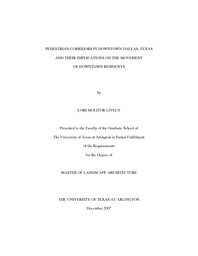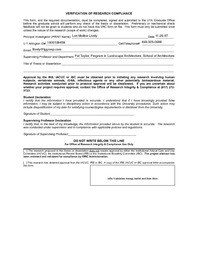
ATTENTION: The works hosted here are being migrated to a new repository that will consolidate resources, improve discoverability, and better show UTA's research impact on the global community. We will update authors as the migration progresses. Please see MavMatrix for more information.
Show simple item record
| dc.contributor.author | Lively, Lori Molitor | en_US |
| dc.date.accessioned | 2008-04-22T02:41:31Z | |
| dc.date.available | 2008-04-22T02:41:31Z | |
| dc.date.issued | 2008-04-22T02:41:31Z | |
| dc.date.submitted | December 2007 | en_US |
| dc.identifier.other | DISS-1960 | en_US |
| dc.identifier.uri | http://hdl.handle.net/10106/761 | |
| dc.description.abstract | The City of Dallas has embarked upon an aggressive economic redevelopment effort in the downtown area. Economic goals of this redevelopment effort are closely tied to and dependent upon a critical mass of downtown residents. The target number of residents is 10,000 by 2015 (Strategic Engagement: Dallas' Economic Development Plan. City of Dallas, Office of Economic Development, 2005.) However, the urban form of downtown Dallas is a vehicle-oriented network of streets. Although downtown residency numbers have climbed from only 896 (excluding institutionalized persons) to 2,277 in the decade between 1990 and 2000 (Census.gov) and was estimated by the metropolitan planning organization to be 5,646 in 2005, no study has documented the location and travel mode choices of these residents. However, recent planning efforts have created physical pathways for pedestrian movement in the Main Street area.
Using concepts pioneered by landscape ecology, a wildlife behavior model theory, and surveys of downtown residents and key decision makers, patches and corridors utilized by downtown residents were mapped and analyzed. A new network of corridors was also recommended to better connect the patches identified in the study. In addition to the current land uses and activities, future nodes of activity were predicted along the corridors. These new were nodes predicted based on accessory activity attracted by the presence of large numbers of pedestrians.
An active street life is generally understood to be a desirable quality in attracting redevelopment to downtown areas. This study found that the lack of existing pedestrian corridors connecting patches of downtown activity inhibited pedestrian activity and promoted vehicular options, thus decreasing an active street life. The connection of patches within the habitat of downtown residents through designated corridors is applicable to any large urban centers with downtown populations. However, to be effective, the process of identifying patches relevant to populations must be conducted prior to corridor implementation and public entities, such as city planning and zoning regulations, must recognize and support creation of these corridors. | en_US |
| dc.description.sponsorship | Taylor, Pat D. | en_US |
| dc.language.iso | EN | en_US |
| dc.publisher | Landscape Architecture | en_US |
| dc.title | Pedestrian Corridors In Downtown Dallas, Texas And Their Implications On The Movement Of Downtown Residents | en_US |
| dc.type | M.L.A. | en_US |
| dc.contributor.committeeChair | Taylor, Pat D. | en_US |
| dc.degree.department | Landscape Architecture | en_US |
| dc.degree.discipline | Landscape Architecture | en_US |
| dc.degree.grantor | University of Texas at Arlington | en_US |
| dc.degree.level | masters | en_US |
| dc.degree.name | M.L.A. | en_US |
| dc.identifier.externalLink | https://www.uta.edu/ra/real/editprofile.php?onlyview=1&pid=1152 | |
| dc.identifier.externalLinkDescription | Link to Research Profiles | |
Files in this item
- Name:
- umi-uta-1960.pdf
- Size:
- 2.329Mb
- Format:
- PDF
- Name:
- VRC_Form.pdf
- Size:
- 1.782Mb
- Format:
- PDF
This item appears in the following Collection(s)
Show simple item record



